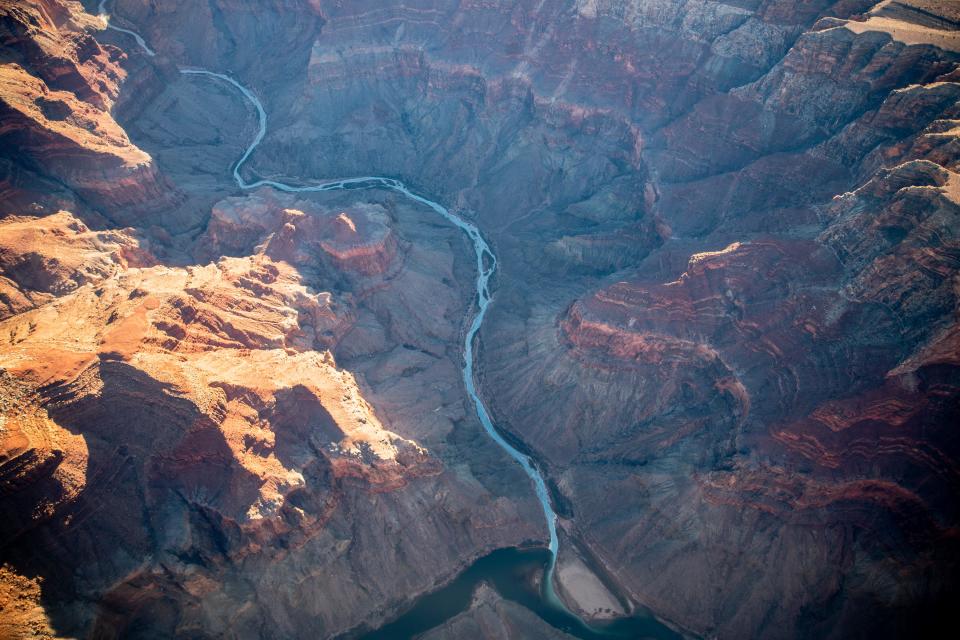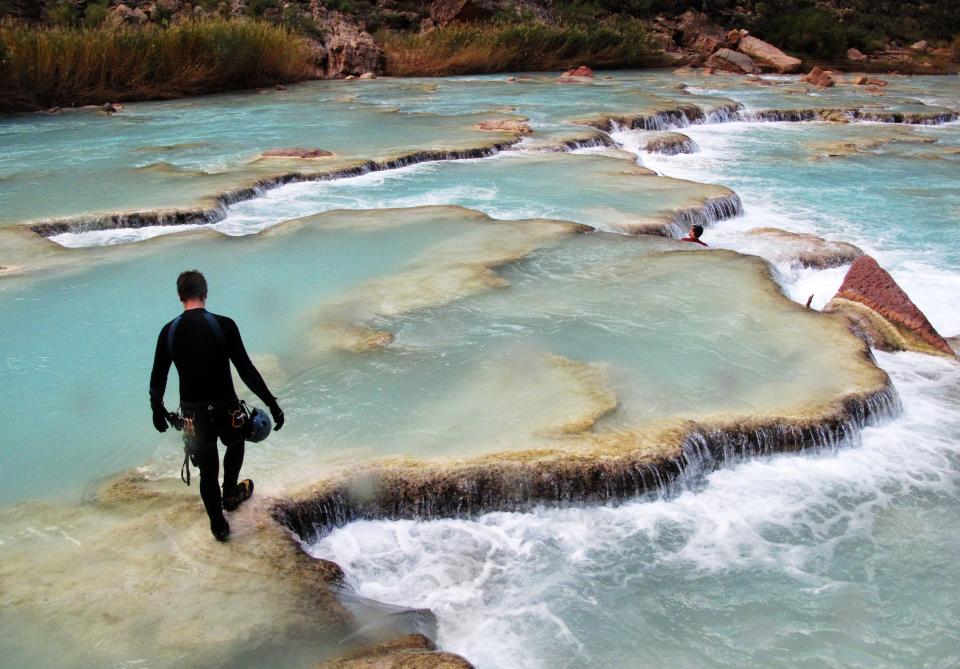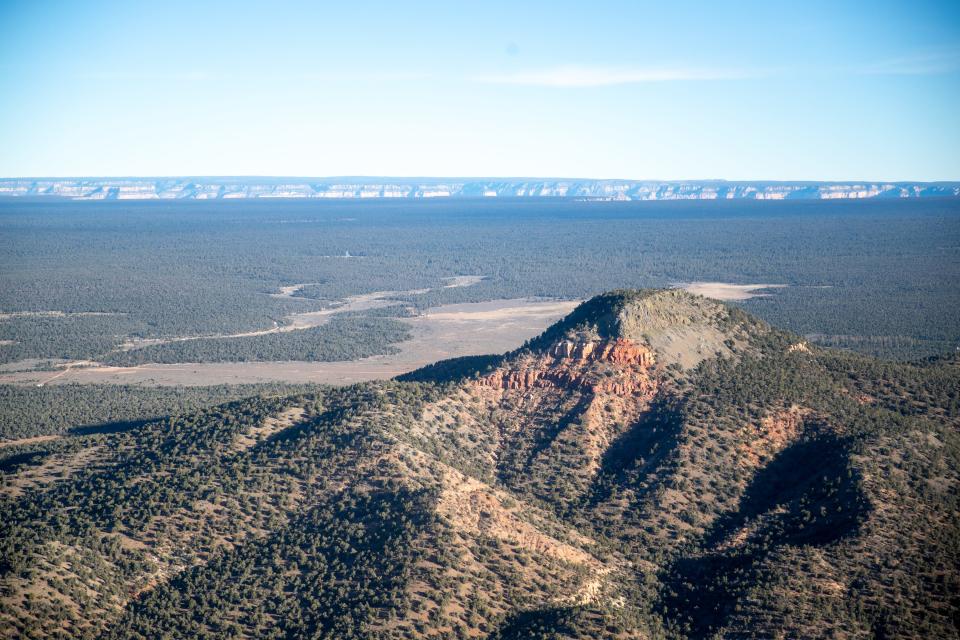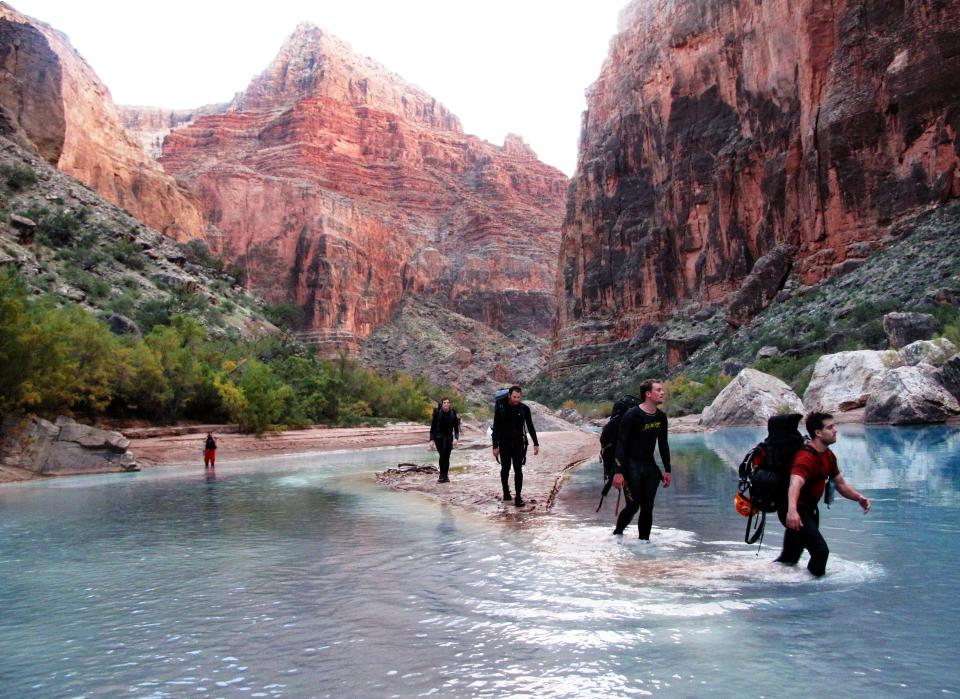'Water is life': Native leaders honor sacred river spaces as courts debate water rights
Mona Polacca has never seen Sípàapu, a place of emergence on the Little Colorado River according to Hopi creation teachings. But she knows it is a sacred place that deserves protection.
The Sípàapu is a limestone dome that sits on the banks upstream from the confluence of the Little Colorado and the mainstem Colorado River at the bottom of the Grand Canyon, which the Hopi call Ӧng’tupkya.
Last month, the International Committee on Monuments and Sites International Science Committee traveled to Flagstaff to present the Black Mesa Trust, a Hopi grassroots organization, with the Water and Heritage Shield designated for the Sípàapu.
“I showed them a picture of the waterfall that is down in the Grand Canyon, Supai,” said Polacca, who is Havasupai, Hopi and Tewa, and who had worked on gaining recognition for the Sípàapu with the heritage shield. “I said, ‘it’s beautiful, isn’t it? Isn’t it worth saving? How can we get recognition of our sacred waters?’”

The presentation was made amid new debate over the future of water in tribal communities and on the Colorado River. The U.S. Supreme Court heard arguments last month in a case that could force the federal government to apportion water from the river to the Navajo Nation, which has sought a water rights settlement for years.
“We’ve been waiting half a century for the political branches to solve this problem for the nation," Shay Dvoretzky, an attorney for the Navajo Nation, told justices. "It hasn’t happened.”
The significance of the rivers runs deep for the Indigenous communities in the region.
“We are here with the same vision, the same goal, of preserving our waters, our natural resources,” said former Hopi Chairman Ben Nuvamsa after the international group made its presentation. “Sípàapu has importance for us. That’s where we believe we emerged from the Third World to here. That’s why it's really important. When we go through our lives, and end our lives, we go home to the place of emergence.”
ICOMOS is a non-governmental international organization that works for the conservation and protection of cultural heritage places. The group is the only global non-government organization of its kind, dedicated to promoting the application of theory, methodology and scientific techniques to the conservation of the architectural and archaeological heritage. The water and heritage shield bestowed upon Sípàapu is the first the group has given.
Sacred spaces: Indigenous people find legal, cultural barriers to protect land
River is 'a sanctuary for mankind'
Preserving and protecting Sipàapu has been a priority for Black Mesa Trust. The overuse of the Little Colorado River basin water system by corporations, towns and cities in Coconino, Navajo and Apache counties has at times left the limestone mound without flowing water.
Black Mesa Trust was established in 1999 to address the severe environmental impact and destruction created by Peabody Coal Company’s water withdrawals from the Navajo aquifer. The group works on advocacy initiatives and develops formal programs to educate and prepare children for future leadership and stewardship of land and sacred water.

A proclamation from members of independent self-governing villages of Lower Moencopi, Upper Moencopi, Hotevilla, Bacavi, Oraivi, Kykotsmovi, Shungopavy, Shipaulovi, Mishongnovi, Walpi, Sichomovi, Tewa and Spider Mound called on the National Historic Landmark Program to officially designate Sípàapu as a Traditional Cultural Place.
“Sípàapu, located at the bottom of Ongtupkya, is the place of emergence to what is now called the Colorado Plateau,” said Vernon Masayesva, chairman of Black Mesa Trust. “This was the place they were looking for to begin a new civilization. It is a sanctuary for mankind we call waaki.”
Masayesva said their belief about the nature of water is that water has many faces, ranging from a benevolent face to a destructive face. He said water reacts to human emotion and has memory.
“It is indestructible. Water is alive, it is life,” he said. “Mankind needs to embrace a new paradigm about the nature of water. A paradigm that mankind is not Master of Water, water is the master, so we must learn to work with and respect water.”

Polacca is part of the Indigenous World Forum on Water and Peace, and is also the water ethics coordinator for the Indigenous Environmental Network. Polacca said through networking she was able to meet with the International Committee On Monuments and Sites International Science Committee and start work on getting the shield protection for Sípàapu.
“Water today is being over-allocated, being polluted beyond imagination, being sucked out of the earth without taking the time for it to replenish and recharge,” said Polacca. “It seems like a lot of the times we as Indigenous people are the only ones who remind the nation and the state, to think beyond what they think they must consume.”
Fight for water: Arizona tribes wait for settlements that languish in courtrooms and bureaucracy
Preserving water and fighting for rights
An ongoing legal case has renewed attention to Indigenous water preservation and water rights. Oral arguments were heard last month at the U.S. Supreme Court in cases involving the Navajo Nation and its water claims.
At issue is whether the United States has a treaty-based duty to assess the Navajo Nation’s water needs and develop a plan to meet them. One of the questions is whether a lower federal court order requiring the U.S. to develop that plan would conflict with the court’s landmark decree in Arizona vs. California, a decision that has shaped the use of Colorado River water for decades.
Teresa Montoya, a member of the Navajo Nation and assistant professor at the University of Chicago, conducts research into water insecurity and the politics of water governance of the Colorado River. She ruminated on the oral arguments of that day.
She said Frederick Liu, assistant to the U.S. solicitor general, argued that the federal government has already provided funds for infrastructure development and that "in exercising its own sovereignty, the Navajo Nation is free to develop its own infrastructure projects including by drilling to access the cheapest source of water on the reservation: groundwater."
“In this argument," Montoya said, "there is an attempt to not only disavow the trust responsibilities to secure water — affirmed by the court's own Winters Doctrine in 1908 — but also to position our own tribal sovereignty as the limitation to water development in the Navajo Nation.”

She said Liu proposed groundwater as a feasible solution for water development, "as if that were the question under consideration here. Let us not forget that the Navajo Nation is the site of over 500 abandoned uranium mines as a consequence of Cold War-era US-sponsored munitions and energy development, not to mention the depletion of our groundwater resources for coal extraction in Black Mesa, or the fact that we are experiencing a decade's long epoch of drought.”
The Navajo Nation is entitled to water from the Colorado River because groundwater is simply not enough and because existing water impacts were created to prioritize states over tribes, she said.
“The federal government has a legal and moral obligation to uphold its treaty promises to ensure access to tribal water,” said Montoya. “The question of infrastructure is a moot point if we don't even have legal entitlements to the Colorado River. The denial of this possibility would have far-reaching implications for tribal water rights across the Colorado River basin and Indian Country as a whole.”
Little Colorado: Navajo communities close access to Grand Falls after a surge in water and visitors
Protecting the land with a new monument
As Black Mesa Trust looks to preserve the Sípàapu, and the Navajo Nation fights for water, the Grand Canyon Tribal Coalition has asked President Joe Biden to designate 1.1 million acres of ancestral tribal and federal public land around Grand Canyon National Park as the Baaj Nwaavjo I’tah Kukveni Grand Canyon National Monument.
The proposed monument spans the ancestral homelands of several regional tribes and builds on efforts since 2008 to permanently protect Grand Canyon’s adjoining landscapes from new uranium mining.
“The Supai are the only people kicked out of the Grand Canyon in 1918, so that we could have a national park in 1919,” said Hopi musician Ed Kabotie. “And today they're the only people that are threatened by the existence of the only operating uranium mine in the state of Arizona because all the other tribes, because of Navajo Nation's experience, have outlawed uranium mining.”

Kabotie, who spoke at the International Committee On Monuments and Sites International Science Committee shield ceremony, noted that Arizona, Flagstaff, and the U.S. government have taken the position that Hopi has no right to the waters of the Little Colorado River because the river lies outside the reservation boundary, a boundary “that they drew" around Hopi.
“Hopi is the oldest continuously inhabited community in all of North America,” said Kabotie. “Flagstaff has been here for like only 150 years, but they're making the rules for us.”
Before the ceremony, Polacca said she was at the United Nations for a water conference attended by Indigenous people from all over the world. This is where they drafted and adopted an Indigenous peoples' water declaration.
“I know that many, many Indigenous people throughout the world have been sending their statements and have been doing this work to protect their waters,” said Polacca. “All over the world Indigenous people like us have maintained their connection to their origin, their land, their water.”
Arlyssa Becenti covers Indigenous affairs for The Arizona Republic and azcentral. Send ideas and tips to arlyssa.becenti@arizonarepublic.com.
Support local journalism. Subscribe to azcentral.com today
This article originally appeared on Arizona Republic: As Supreme Court considers water rights, Native leaders honor rivers

